Whether you’re an analytics newbie, nerd or ninja, it always helps to follow best practices when setting up new Google Analytics profiles. SEER’s best practices for all of our analytics setups include some tried-and-true methods to follow, which I’ll share with you below!
To start - Why do I even need Profiles in Google Analytics?
When you set up a Google Analytics property for a domain, Google Analytics automatically names the profile “All Web Site Data [DEFAULT].” This profile receives all of the raw data for your property and while this isn’t necessarily a bad thing, the raw data, in many cases, is not the most accurate data.
The solution to inaccuracies in the raw data is to create multiple profiles for the same property. The advantage of these profiles is they allow you to create separate views of the data being pulled into Google Analytics, while also being able to clean up the data that the profile receives. Think of profiles as viewing your website’s data through different lenses. Each lens (profile) is created by applying filters according to what you would like to view.
For instance, let’s say you don’t want to view the stats on all of the visitors to your site, just your mobile visitors. With the use of a profile, you can apply a filter that includes only mobile visits. You now have a lens through which you can view just the analytics of your mobile visitors.
So which profiles should I set up?
There is a default list of three profiles that SEER always recommends creating:
- Raw Profile
- Test Profile
- Overall Profile
There are also other profile types that can be helpful when analyzing data including:
- Organic Profile
- PPC Profile
- Mobile Profile
Lets start with details on SEER’s default profiles.
Raw Profile
The first profile you’ll want to set up is a Raw profile. This is the easiest profile to set up, because there are no filters involved.
Why?: The advantage to creating a Raw profile is that the analytics data in this profile is completely raw and unfiltered. If any of your other profiles have issues with your Google Analytics setup you will be able to refer to your raw data to get to the bottom of the issue, or recover data that could otherwise have been lost. This is a valuable asset, as Google Analytics will not repopulate the data in a profile, even if filters are removed or adjusted.
To create this profile you can do one of two things. If no filters have ever been applied to your default profile, you can use this as your Raw profile and rename it accordingly.
If you do need to create a brand new Raw profile, simply select ‘New Profile’ button under the Profiles Tab in the Admin section of your existing domain account in Google Analytics. That’s it, you’re done! Just make sure no filters are ever applied to this profile so you’re always receiving the raw data.

Test Profile
The second profile you’ll want to create is the Test profile.
Why?: The Test profile provides you with a place to test filters or goals to make sure they’re tracking properly before implementing them in any of the main profiles you use for reporting.
The setup of this profile is identical to the Raw Profile in that it has no filters applied. This profile can be used any time you want to test potential filters or goals you would like to eventually implement without affecting any of the data in your main profiles.
Again, since GA won’t repopulate your data, testing everything you would like to eventually implement in your main reporting profiles will let you make mistakes and try different strategies for gathering data, without affecting any of the data in your main profiles.
Overall Profile
Note: SEER calls this our “Overall” profile, but you can call it whatever will indicate to you and other members of your team that this is the primary profile that should be used for reporting purposes.
Why?: The Overall profile allows you to view only the traffic that you consider relevant, while excluding any traffic that you consider irrelevant.
You can use filters for this profile to exclude visits that come from a company’s internal employees visiting the site, developers working on the site, yourself, visits coming from the wrong hostname(s), etc . Rather than just talking about these filters, we’re going to show you a few basic filters.
Keep in mind that when applying these filters, they are, by default, applied to the data in the order in which they are added. It’s also important to ensure any filter patterns you enter are in lowercase.
Below are the filters you’ll apply to the Overall Profile.
Filter A: Include Hostname
- This filter allows only visitors to your chosen domain(s) in your analytics. This allows you to exclude visitors from any hostname that may be irrelevant.
- For instance if you have a development site on a subdomain of your site, such as Dev.FakeDomain.com, you’ll want to include only visits to your main hostname, as visitors to the development site are not considered part of the relevant visits to your site.
- Or, if someone has inadvertently (or maliciously) included your GA code on their site, this prevents their visitors from appearing in your analytics.
- If you’re wondering how to distinguish which hostnames your visitors are currently coming from, you can view the following report in analytics under the Audience tab:
- Audience>>Technology>>Network
- Then Select the Primary Dimension: Hostname
- Now you can see which hostnames visitors are coming from and which hostnames you want to include as your relevant visitors.
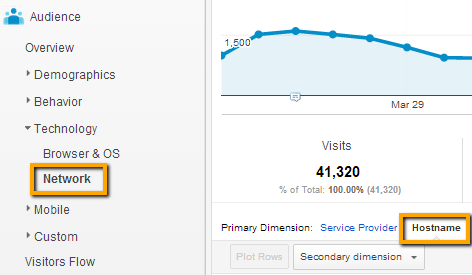
- After you’ve determined your chosen hostnames, you’ll create a custom filter to include the filter field ‘Hostname’.
- For instance, for this filter pattern, to include only visitors to the main hostname, you’ll enter: ^www.fakedomain.com$.
- For a basic tutorial on the Regular Expressions you’ll need for hostname filters, check out this intro on RegEx from Google.
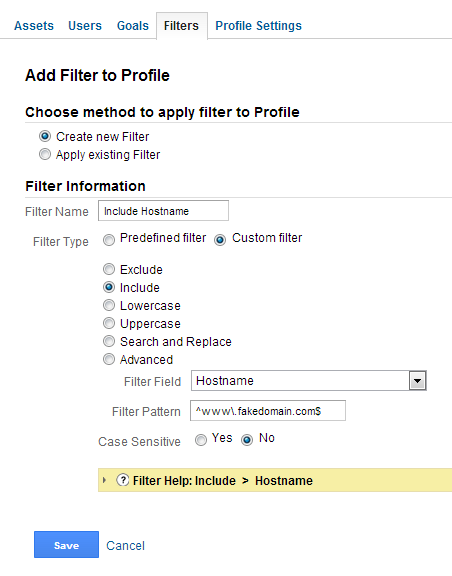
Filter B: Remove Upper & Lowercase Redundancies
- Google Analytics will separate data for URIs (uniform resource identifiers) if there are variations written with either uppercase and lowercase letters. To avoid this redundancy, you can apply the lowercase URI filter so that GA will not distinguish between the same page with different upper and lowercase settings.
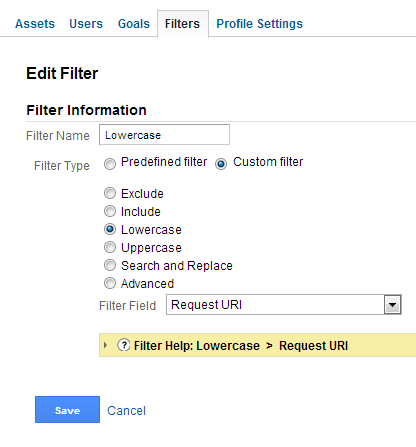
Additional Filters: Exclude IP Addresses
- It is often necessary to exclude certain IP addresses in order to remove data from irrelevant visitors from your profiles. For instance, for the domain of a business, the office IP address of the businesses’ employees will need to be excluded. Another instance where you’ll want to exclude IP addresses is to exclude any offices that work with the business such as SEO agencies, marketing & design agencies, developers, etc.
- To set this filter up, you’ll need to create a custom filter to exclude the filter field ‘IP Address’ and then in the filter pattern, include the IP address you wish to exclude.
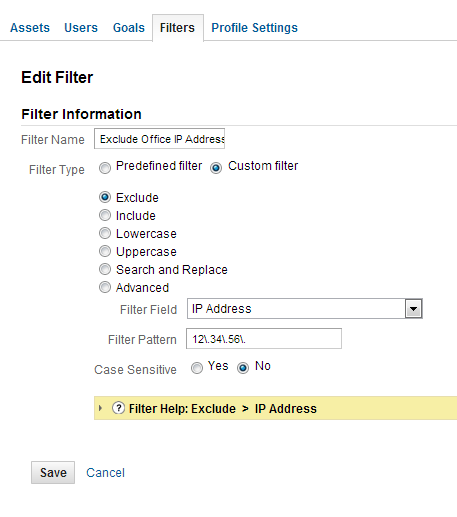
Along with these best-practice profiles that allow you to more accurately analyze the visitors to your domain, you can also setup additional, optional profiles that provide data specific to certain types of visitors.
If you have certain information you always need to look at, isn’t it annoying when you have to filter or apply advanced segments to reports every time, in order to drill down to what you’re actually looking for? Using filters to limit the data in a profile to only this information makes it quick and easy to access the data across every report, without needing advanced segments every time. Three profile options for this are below:
- Organic Profile
- PPC Profile
- Mobile Profile
Organic Profile
Why?: This profile allows you to view the analytics data of only the organic visits to your site. This is especially helpful if you’re carrying out search engine optimization strategies. It will allow you to track the volume of organic traffic, the keywords they’re reaching your site from and the landing pages they’re reaching (without having to dig through all of your visitor data to distinguish who is organic and who isn’t).
This profile uses Filters A (Include Hostname) and B (Remove Upper & Lower Case Redundancies) used in the Overall Profile and then uses Filter C below:
Filter C: Include only Organic Traffic
- In this filter setup, you’ll apply a custom filter to include visitors from the ‘Campaign Medium’ that you’ll define as ‘organic’.
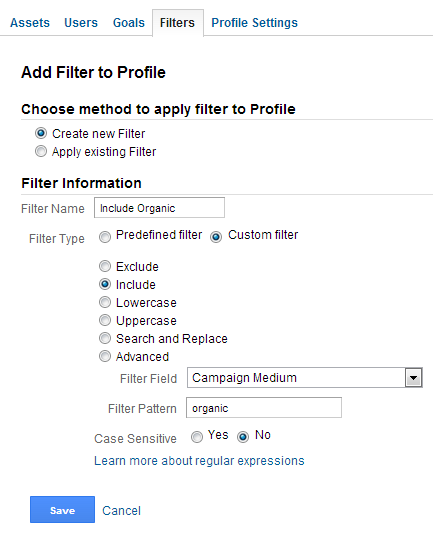
PPC Profile
Why?: This profile allows you to view the analytics data of only the paid search visitors to your site. So, whether you’re running campaigns on Google AdWords, Microsoft AdCenter or any online ad service, you can view the progress of these campaigns without having to dig through all of your visitor data.
This profile uses Filter B (Remove Upper & Lower Case Redundancies) used in the Overall Profile and Filter D below:
Filter D: Include only PPC Traffic
- For this filter setup, you’ll create a custom filter to include the ‘Campaign Medium’ for your paid search visits. Paid search visitor data can be pulled into analytics labeled either as PPC or CPC. So, to define this ‘Campaign Medium’ you’ll need to use a simple regular expression to include either of these options, as ‘cpc|ppc’.
- Also, if you have other paid search campaigns that will appear in analytics from something other than CPC or PPC (for instance an email marketing campaign), then you can include that parameter in the ‘Campaign Medium’ you define.
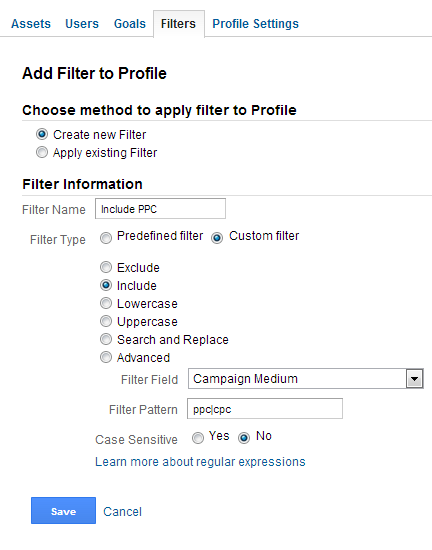
Mobile Profile
Why?: This profile allows you to view the analytics data of your traffic from mobile devices. This is important if your mobile traffic behaves differently across the site.
This profile uses Filters A (Include Hostname) and B (Remove Upper & Lower Case Redundancies) used in the Overall Profile and then uses Filter E below:
Filter E: Include only Mobile Traffic
- For this filter setup, you’ll create a custom filter to include the Filter Field ‘Mobile?’ and then the filter pattern ‘yes’.
- Now you can view the behavior and data of your mobile visitors separate from your general visitors without having to do deep drilldowns in analytics reporting.
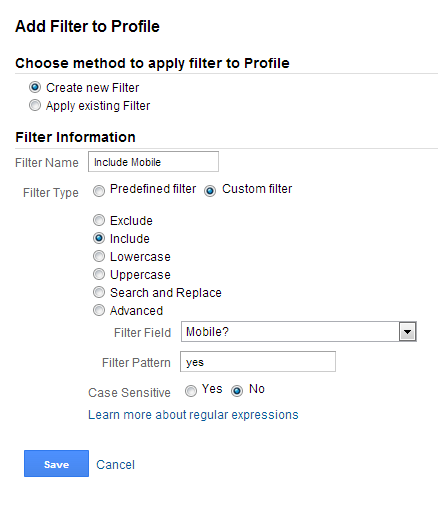
Using these best-practice profiles and optional profiles for your domain account in Google Analytics, you’ll be able to view more accurate data for your visitors and you’ll be able to access this data without digging through levels and levels of analytics reporting.
Do you have any best-practices you employ for Google Analytics Profiles? Leave a comment or let me know on Twitter!


